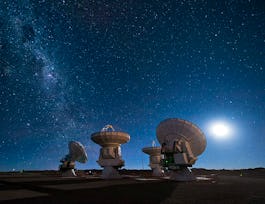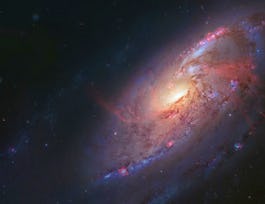Science is undergoing a data explosion, and astronomy is leading the way. Modern telescopes produce terabytes of data per observation, and the simulations required to model our observable Universe push supercomputers to their limits. To analyse this data scientists need to be able to think computationally to solve problems. In this course you will investigate the challenges of working with large datasets: how to implement algorithms that work; how to use databases to manage your data; and how to learn from your data with machine learning tools. The focus is on practical skills - all the activities will be done in Python 3, a modern programming language used throughout astronomy.


Data-driven Astronomy
Taught in English
Some content may not be translated
35,201 already enrolled
(1,336 reviews)
Skills you'll gain
Details to know

Add to your LinkedIn profile
6 quizzes
See how employees at top companies are mastering in-demand skills


Earn a career certificate
Add this credential to your LinkedIn profile, resume, or CV
Share it on social media and in your performance review

There are 6 modules in this course
This module introduces the idea of computational thinking, and how big data can make simple problems quite challenging to solve. We use the example of calculating the median and mean stack of a set of radio astronomy images to illustrate some of the issues you encounter when working with large datasets.
What's included
8 videos1 reading1 quiz3 app items2 discussion prompts
In this module we explore the idea of scaling your code. Some algorithms scale well as your dataset increases, but others become impossibly slow. We look at some of the reason for this, and use the example of cross-matching astronomical catalogues to demonstrate what kind of improvements you can make.
What's included
7 videos1 quiz2 app items1 discussion prompt
Most large astronomy projects use databases to manage their data. In this module we introduce SQL - the language most commonly used to query databases. We use SQL to query the NASA Exoplanet database and investigate the habitability of planets in other solar systems.
What's included
7 videos1 quiz2 app items1 discussion prompt
This module introduces the basic principles of setting up databases. We look at how to set up new tables, and then how to combine Python and SQL to get the best out of both approaches. We use these tools to explore the life of stars in a stellar cluster.
What's included
6 videos1 quiz2 app items
This module introduces the idea of machine learning. We look at standard methodology for running machine learning experiments, and then apply this to calculating redshifts of distant galaxies using decision trees for regression.
What's included
7 videos1 quiz2 app items
In this final module we explore the limitations of decision tree classifiers. We then look at ensemble classifiers, using the random forest algorithm to classify images of galaxies into different types.
What's included
7 videos1 reading1 quiz1 app item1 discussion prompt
Instructors


Offered by
Recommended if you're interested in Physics and Astronomy

The University of Edinburgh

University of Illinois at Urbana-Champaign

Coursera Project Network

University of Rochester
Why people choose Coursera for their career




Learner reviews
Showing 3 of 1336
1,336 reviews
- 5 stars
85.26%
- 4 stars
12.86%
- 3 stars
1.42%
- 2 stars
0.22%
- 1 star
0.22%

Open new doors with Coursera Plus
Unlimited access to 7,000+ world-class courses, hands-on projects, and job-ready certificate programs - all included in your subscription
Advance your career with an online degree
Earn a degree from world-class universities - 100% online
Join over 3,400 global companies that choose Coursera for Business
Upskill your employees to excel in the digital economy
Frequently asked questions
We assume you are familiar with basic programming in a modern programming language including variables, control structures, data structures, functions, and working with files. In this course we will use Python 3.
We'll walk through all the examples and provide lots of support, so jump in and have a go. If haven't done any programming for a while, you might want to brush up before you start.
Access to lectures and assignments depends on your type of enrollment. If you take a course in audit mode, you will be able to see most course materials for free. To access graded assignments and to earn a Certificate, you will need to purchase the Certificate experience, during or after your audit. If you don't see the audit option:
The course may not offer an audit option. You can try a Free Trial instead, or apply for Financial Aid.
The course may offer 'Full Course, No Certificate' instead. This option lets you see all course materials, submit required assessments, and get a final grade. This also means that you will not be able to purchase a Certificate experience.
When you purchase a Certificate you get access to all course materials, including graded assignments. Upon completing the course, your electronic Certificate will be added to your Accomplishments page - from there, you can print your Certificate or add it to your LinkedIn profile. If you only want to read and view the course content, you can audit the course for free.


